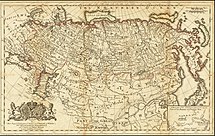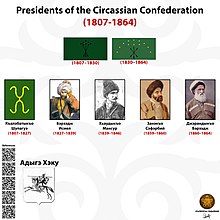
Back الحرب الروسية الشركسية Arabic روس-چرکس ساواشی AZB Guerra ruso-circasiana Spanish Guerre russo-circassienne French המלחמה הרוסית-צ'רקסית HE Perang Rusia-Adighe ID რუსეთ-ჩერქეზეთის ომი Georgian Урыс-адыгэ зауэ KBD Wojny rosyjsko-czerkieskie Polish روس - چرکسی جنگ PNB
This article may require copy editing for grammar, style, cohesion, tone, or spelling. (August 2023) |
| Russo-Circassian War | |||||||||
|---|---|---|---|---|---|---|---|---|---|
| Part of the Caucasian War and Russian imperialism | |||||||||
 | |||||||||
| |||||||||
| Belligerents | |||||||||
|
Aided by: European adventurers (1818–1856)[5] | ||||||||
| Commanders and leaders | |||||||||
|
…and others |
…and others | ||||||||
| Units involved | |||||||||
|
Before 1860: Foreign volunteers | |||||||||
| Strength | |||||||||
| 150,000[12]–300,000[13] regulars | 20,000[14]–60,000[15] regulars | ||||||||
| Casualties and losses | |||||||||
|
24,947 KIA 65,125 WIA 6,007 MIA including 804 officer, 13 general and 21 Commander Civilian deaths: 15,000[17] (Estimate) |
1,200,000+[19][20] 1,615,000+ (Estimate)[19][20] | ||||||||
| During the Circassian Genocide, approximately 1.5 to 2 million Circassian natives were slaughtered;[21] and about 1,500,000[22][23][24][25][26] indigenous highland Caucasians were mainly expelled to the Ottoman Empire, and a much smaller number of them were expelled to Persia. An unknown number of those who were expelled died during their deportation.[27] | |||||||||
| Part of a series on the |
| Circassians Адыгэхэр |
|---|
 List of notable Circassians Circassian genocide |
| Circassian diaspora |
| Circassian tribes |
|
Surviving Destroyed or barely existing |
| Religion |
|
Religion in Circassia |
| Languages and dialects |
|
| History |
|
Show |
| Culture |
| History of Russia |
|---|
 |
|
|

The Russo-Circassian War,[a] also known as the Russian invasion of Circassia, was the invasion of Circassia by Russia,[28] starting in 1763 (O.S) with the Russian Empire assuming authority in Circassia, followed by the Circassian refusal,[29] and ending 101 years later with the last army of Circassia defeated on 21 May 1864 (O.S), making it exhausting and casualty-heavy for both sides. The Russo-Circassian War was the longest war both Russia and Circassia have ever fought and the longest war in the Caucasus region.[30][31][32]
During and after the war, the Russian Empire employed a genocidal strategy of systematically massacring civilians which resulted in the Circassian genocide[33][34][35][36] where up to 3,500,000 Circassians[37] were either killed or forcibly expelled to the Ottoman Empire (especially to modern-day Turkey; see Circassians in Turkey)[b], creating the Circassian diaspora.[28] While the war was initially an isolated conflict, Russian expansion through the entire region soon drew a number of other nations in the Caucasus into the conflict. As such, the war is often considered the western half of the Caucasus War.
During the war, the Russian Empire did not recognize Circassia as an independent polity, instead seeing Circassia as part of Russia, which was under rebel occupation, despite the fact that the polity was not and had never been under Russian control.[45] Russian generals did not refer to the Circassians by their ethnic name. Instead, they called the Circassians "mountaineers", "bandits", and "mountain scum".[45][46]
The war has been subjected to historical revisionism and it has also garnered controversy due to the fact that later Russian sources mostly ignored or belittled the conflict, and Russian state media and officials have gone as far as to claim that the conflict "never happened” and they have also claimed that Circassia "voluntarily joined Russia in the 16th century".[30][47] Several Russian imperial historians have recorded the expulsion and extermination campaign against Circassians by Russian military during the 1860s. Adolf Berzhe portrayed the expulsion of Circassians as essential for "Russian security" while Rostislav Fadeyev described the campaign as “one of the most vital tasks in Russian history.” In 1861, Russian Tsar Alexander II publicly declared the imperial policy as the expulsion of all Circassians; followed by the state implementation of settler-colonial Russification and Christianization programs across Caucasus.[48]
- ^ "Kafkas Rus Savaşı". Cerkesyaorg (in Turkish). Retrieved 16 May 2021.
- ^ Gvosdev 2000, pp. 111–112.
- ^ (in Georgian) "გურიის სამთავრო" (Principality of Guria). In: ქართული საბჭოთა ენციკლოპედია (Encyclopaedia Georgiana). Vol. 3: p. 314-5. Tbilisi, 1978.
- ^ Berkok, Ismail Hakkı (1958). Tarihte Kafkasya. Istanbul.
{{cite book}}: CS1 maint: location missing publisher (link) - ^ Richmond 2008.
- ^ Çirg, Ashad (1993). "Adıgelerin XIX. yüzyıldaki politik tarihinin incelenmesi gerekir" [Adyghe XIX. century political history needs to be studied]. Kafkasya Gerçeği dergisi (in Turkish). 11: 61–62.
- ^ Василий Потто — Кавказская война. Том 1. От древнейших времен до Ермолова.
- ^ Çirg, Ashad (1993). "Adıgelerin XIX. yüzyıldaki politik tarihinin incelenmesi gerekir" [Adyghe XIX. century political history needs to be studied]. Kafkasya Gerçeği dergisi (in Turkish). 11: 61–62.
- ^ Polvinkina (2007). Çerkesya Gönül Yaram [Circassia Heart Wound] (in Turkish). Ankara. pp. 281–285.
{{cite book}}: CS1 maint: location missing publisher (link) - ^ Askerov, Ali (2015). Historical Dictionary of the Chechen Conflict. Rowman & Littlefield. p. 3.
- ^ Natho, Kadir (2005). "The Russo-Circassian War". Archived from the original on 12 May 2022. Retrieved 10 April 2021.
- ^ Mackie 1856:291
- ^ J. F. B., The Russian Conquest of the Caucasus
- ^ Mackie 1856:292
- ^ A, M. Rus Çerkez Savaşı
- ^ Vedeneyev 1994, p. 123.
- ^ Şamil, Tasoğlu. Rusya’nın Çerkes tarihi
- ^ Hozhay, Dalhan (1998). Чеченцы в русско-кавказской войне [Chechens in the Russian-Caucasian war]. SEDA. ISBN 5-85973-012-8. (in Russian)
- ^ a b Cite error: The named reference
:022was invoked but never defined (see the help page). - ^ a b Richmond, Walter. The Circassian Genocide. ISBN 9780813560694.
- ^ Messenger, Evan (6 December 2023). "The Circassian Genocide: The Forgotten Tragedy of the First Modern Genocide". American University: Journal of International Service. Archived from the original on 23 February 2024.
The corroboration between both Turkish and Russian documents puts the number of Circassian deaths by military operations and pre-planned massacres between 1.5 – 2 million; ...
- ^ a b Richmond, Walter (2013). The Circassian Genocide. Rutgers University Press. back cover. ISBN 978-0-8135-6069-4.
- ^ a b Cite error: The named reference
Ahmed16132was invoked but never defined (see the help page). - ^ a b Cite error: The named reference
:03was invoked but never defined (see the help page). - ^ Cite error: The named reference
:14was invoked but never defined (see the help page). - ^ a b Cite error: The named reference
:22was invoked but never defined (see the help page). - ^ McCarthy 1995:53, fn. 45
- ^ a b King, Charles (2008). The Ghost of Freedom: A History of the Caucasus. New York City, NY: Oxford University Press. ISBN 978-0-19-517775-6.
- ^ a b Henze 1992
- ^ a b Bashqawi, Adel (15 September 2017). Circassia: Born to Be Free. Xlibris. ISBN 978-1543447644.
- ^ King, Charles (2008). The Ghost of Freedom: A History of the Caucasus. New York City, NY: Oxford University Press. ISBN 978-0-19-517775-6.
- ^ Shenfield 1999, p. 150.
- ^ Richmond, Walter (9 April 2013). The Circassian Genocide. Rutgers University Press. ISBN 978-0-8135-6069-4.
- ^ King, Charles (2008). The Ghost of Freedom: A History of the Caucasus. New York City: Oxford University Press. ISBN 978-0-19-517775-6.
- ^ L.V.Burykina. Pereselenskoye dvizhenie na severo-zapagni Kavakaz. Reference in King.
- ^ Richmond 2008, p. 79.
- ^ Messenger, Evan (6 December 2023). "The Circassian Genocide: The Forgotten Tragedy of the First Modern Genocide". American University: Journal of International Service. Archived from the original on 23 February 2024.
- ^ Geçmişten günümüze Kafkasların trajedisi: uluslararası konferans, 21 Mayıs 2005 (in Turkish). Kafkas Vakfı Yayınları. 2006. ISBN 978-975-00909-0-5.
- ^ King 2008:96
- ^ Richmond, Walter (2013). The Circassian Genocide. Rutgers University Press. p. 132. ISBN 978-0-8135-6068-7.
... between 95 percent and 97 percent of all Circassians were killed outright, died during Evdokimov's campaign, or were deported
- ^ Jones, Adam (2017). Genocide: A Comprehensive Introduction (3rd ed.). 711 Third Avenue, New York, NY 10017, USA: Routledge. p. 110. ISBN 978-1-138-78043-9. LCCN 2016025350.
Ninety-five to 97 percent of the entire Circassian population had been killed or deported in what contemporary Russian field reports referred to as an ochishchenie' ("cleansing")
{{cite book}}: CS1 maint: location (link) - ^ Cite error: The named reference
Shenfield 1999was invoked but never defined (see the help page). - ^ Gazetesi, Aziz ÜSTEL, Star. "Soykırım mı; işte Çerkes soykırımı – Yazarlar – Aziz ÜSTEL | STAR". Star.com.tr. Retrieved 26 September 2020.
{{cite web}}: CS1 maint: multiple names: authors list (link) - ^ Эльмесова, А. М. (4 December 2014). ИЗ ИСТОРИИ РУССКО-КАВКАЗСКОЙ ВОЙНЫ.
- ^ a b Richmond, Walter (9 April 2013). The Circassian Genocide. Rutgers University Press. ISBN 978-0-8135-6069-4.
- ^ Capobianco, Michael (13 October 2012). "Blood on the Shore: The Circassian Genocide". Caucasus Forum.
- ^ Cite error: The named reference
ReferenceAwas invoked but never defined (see the help page). - ^ Richmond, Walter (2013). "4: 1864". The Circassian Genocide. New Brunswick, New Jersey, USA: Rutgers University Press. p. 96. ISBN 978-0-8135-6068-7.
Cite error: There are <ref group=lower-alpha> tags or {{efn}} templates on this page, but the references will not show without a {{reflist|group=lower-alpha}} template or {{notelist}} template (see the help page).
© MMXXIII Rich X Search. We shall prevail. All rights reserved. Rich X Search